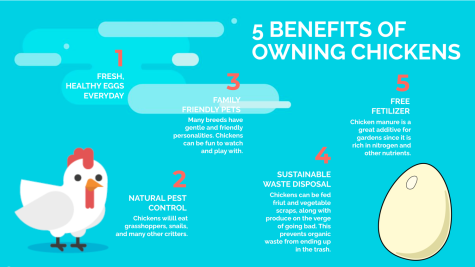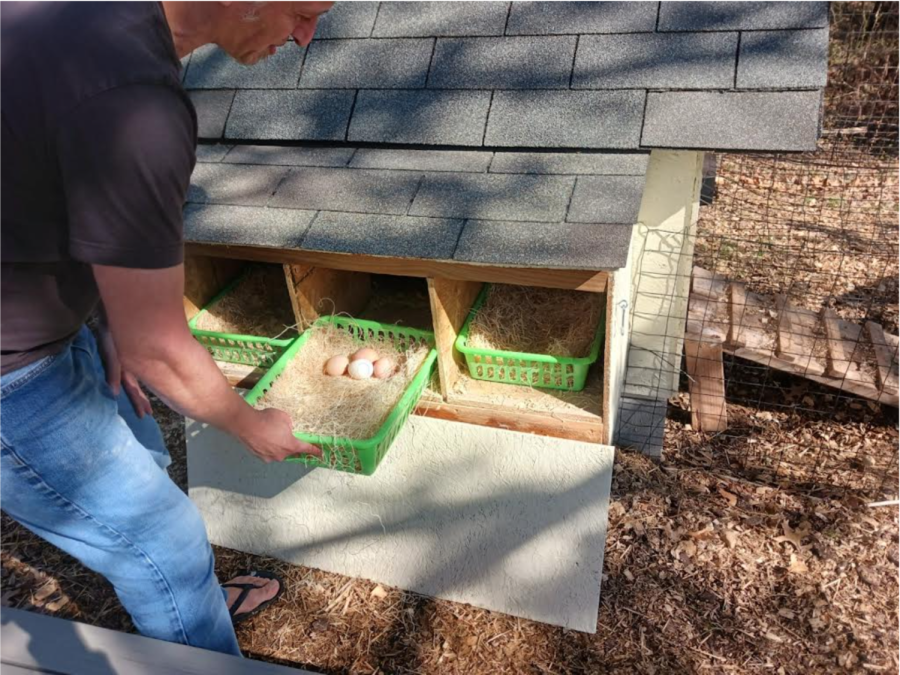Chicken Before the Egg…
COVID, inflation prompt owners to expand their flocks
Media by David Moss
Zach Avila, architectural engineering teacher, removes eggs from his chicken coop. He said they often have an abundance of eggs, and they usually give some away to friends and family.
Zach Avila, architectural engineering teacher, had always thought about getting chickens.
“My wife and I had been discussing it forever,” Avila said. “We’ve also had friends and neighbors that have had chickens.”
About a year ago, Avila and his wife offered to “babysit” a friend’s two recently adopted chickens while they and their family were out of the country. With the friend’s urging, this supposedly brief babysitting arrangement soon became permanent, and suddenly, the Avilas had chickens.
“We ended up with a total of five,” Avila said. “They’re all different breeds, so they’re different colors and easily recognizable.”
Within the last two months, Avila said all five hens—Cha Cha, Chicky, Lola, Lucy and Ruby—have been producing eggs. Each chicken lays four to five eggs each day, amounting to an average total of 30 eggs per week.
“We’re just fortunate that we don’t have to buy them,” Avila said. “Just out of curiosity, I’ll look at the price at the grocery store to see how expensive eggs are, and it is quite surprising that they’re two to three times more expensive than they used to be.”
Inflation and supply chain issues have been cited as contributing factors to the explosion in prices; however, the avian flu has been the primary factor, causing the deaths of millions of chickens. Nearly 60

million chickens have been affected by the virus, according to the US Department of Agriculture.
With egg prices jumping from under $2 at the start of last year to more than $4 this year, chicken hatcheries across the country have seen a massive increase in orders.
Tom Watkins, president of Murray McMurray Hatchery in Iowa, said they have had almost 1,000 phone calls a day.
About 75% of McMurray’s orders are placed online, and the rest are placed over the phone. Collectively, Watkins said the hatchery has been placing roughly 1,000 orders for eggs each day.
“This is a little bit earlier than usual for our peak season because we’ve seen a rise in early orders,” Watkins said.
Watkins said COVID-19 has been part of the reason for this increase in egg orders.
“People were getting chickens because they always wanted to, and now they had time,” Watkins said.
This year, motivated by high egg prices in stores, Watkins said many existing customers decided to expand their flocks.
“It’s not necessarily new people. It’s people who come to take that next step from just raising chickens for fun, a hobby or for their own use,” Watkins said. “Now’s an opportunity for them to try to sell something and to supply neighbors with these eggs.”
Nevaeh Kerber, sophomore, has had chickens on and off since she was 6 years old. Her family now has seven chickens, along with the other animals on their farm, including pigs, horses, bunnies, a goat, a cow, a donkey, giant tortoises, snakes, a fallow deer, a mini ostrich and a zebra.
“We started hatching eggs over COVID, so the chickens that we have now we actually hatched,” Kerber said.
Their chickens each produce an egg almost every day, which amounts to nearly 50 eggs weekly.
“We give a lot away because there’s just too many,” Kerber said. “The price of chicken food has increased, but we haven’t had to buy eggs, so that’s been nice.”
Chickens are not without their costs. Along with chicken feed, they also require scratch, a mixture of whole grains, seeds and legumes; grit, small rocks for digestion; oyster shells, a source of calcium, and bedding for their coop that needs to be replaced consistently.
Keeping them warm at this time of year also proves a challenge.
Avila said his family’s primary motive is the joy that comes with raising them.
“For us, they’re just a bunch of pets,” Avila said. “I wouldn’t recommend chickens for anybody who just wants to save money. I’d recommend it if they like animals and want to grow their own food.”
Your donation will support the student journalists of Marquette High School. Your contribution will allow us to purchase equipment and cover our annual website hosting costs. You may become a PATRON by making a donation at one of these levels: White/$30, Green/$50, Blue/$100. Patron names will be published in the print newsmagazine, on the website and once per quarter on our social media accounts.

David Moss, senior, is one of the editors-in-chief for the Marquette Messenger. This is his second full year on staff. David participates in cross country...




